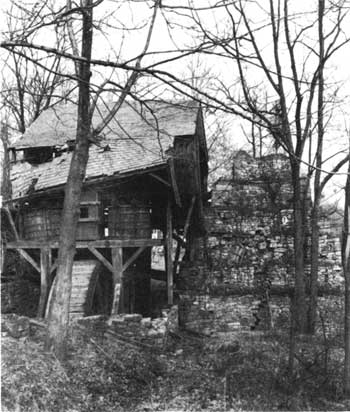|
HOPEWELL VILLAGE National Historic Site |
 |

Ruins of Hopewell Furnace and its blast machinery about 1925.
Colonial Iron Industry in Pennsylvania
Other ironworks were soon afterwards established in New Jersey and Maryland. Principio, the first ironworks in the latter colony (1715), was owned in part by Augustine Washington, the father of George Washington. But it was in Pennsylvania that colonial iron manufacture was destined for its most striking expansion. Scattered over the southern portion of the State—especially in the Schuylkill Valley, in the wide Susquehanna Valley, along the beautiful blue Juniata, and across the wooded Alleghenies—may still be found the ruins of old furnaces. Each ruin—a pile of stones intertwined with leaves and the wild growth of bramble—was once the scene of great activity, the center of a community where the ironmaster and his dependents lived and labored.
Although the majority of such "iron plantations" had their origins in the eighteenth century, many remained until the nineteenth, and even later. With the development of large-scale capitalistic enterprise and consolidation after the Civil War, however, they gradually disappeared and became mere memories.
Not a single ironworks was built in Pennsylvania until long after the English Quakers settled there, although William Penn knew of the presence of iron ore in his colony and was himself connected with iron manufacture in England. The first colonists, mostly Dutch and Swedes, were concerned primarily with fighting for a foothold in the New World, and they made their livelihood by farming, shad fishing, and trade with the Indians. Other nationalities came in after 1681, bringing many families whose names were to become famous in the early American iron industry. There were Englishmen like Thomas Rutter, William Bird, and John Ross; men of Welsh origin like James Morgan, Thomas Potts, and James Old; and Germans like John Lesher and Henry William Stiegel, the latter perhaps better known for his great work in the field of glass manufacture. Other pioneer ironmasters claimed Ireland, Scotland, and France as their place of birth. Many of the sons of these men also learned the iron business, so that by 1800 most of the important industrial leaders of Pennsylvania were native-born.
The first bloomery forge in Pennsylvania was built in 1716 by Thomas Rutter, near what is now Pottstown. Three or four years later, aided by his friend Thomas Potts, Rutter also built the colony's first furnace, Colebrookedale. Further south, at Coventry, Samuel Nutt, Sr., built a bloomery forge which in time became the famous Coventry Iron Works, boasting refinery forges, a blast furnace, and even a steel furnace. It was the first in the province, built in 1732. Mordecai Lincoln, great-great grandfather of President Abraham Lincoln, was one of the partners. After this, progress was rapid. By 1771, there were more than 50 iron forges and furnaces in the province, and at the close of the eighteenth century, iron plantations had been established as far as the western borders of Pennsylvania, and even beyond. Reading (Redding), Warwick, Coventry, Cornwall, Hopewell, Mount Hope, Durham, and Elizabeth were but a few among these many early works, the ruins of which stand today as monuments to a race of fearless ironmasters who faced tremendous difficulties in obtaining capital, securing skilled workmen, and dealing with metallurgical problems in an age of experimentation.

|

| History | Links to the Past | National Park Service | Search | Contact |
|
Last Modified: Mon, Dec 2 2002 10:00:00 am PDT |

